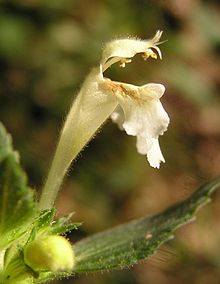Yellow hollow tooth
| Yellow hollow tooth | ||||||||||||
|---|---|---|---|---|---|---|---|---|---|---|---|---|

Yellow hollow tooth ( Galeopsis segetum ) |
||||||||||||
| Systematics | ||||||||||||
|
||||||||||||
| Scientific name | ||||||||||||
| Galeopsis segetum | ||||||||||||
| Neck. |
The yellow hollow tooth or seed hollow tooth ( Galeopsis segetum ) is a plant from the genus hollow tooth ( Galeopsis ) within the family of Labiatae (Lamiaceae).
description
Vegetative characteristics
They are annual herbaceous plants that reach heights of 10 to 50 cm. The stem nodes are at most very slightly thickened in this species. In the case of the multicolored hollow tooth , the stem nodes are clearly thickened and hairy with bristles. The leaves of the yellow hollow tooth stand opposite to each other on the hairy and square stem. They are ovate-lanceolate with a roughly serrated leaf margin .
Generative characteristics
The hermaphrodite flowers are zygomorphic with a double flower envelope . The 2 to 3 centimeters long corollas are pale yellow to whitish, often with a yellow throat and sometimes with small purple throat spots. However, the entire lower lip is never purple, as is sometimes the case with similar colored hollow teeth . Just like the upper leaves, the flowers are downy and hairy with glands. The flowering period in Germany extends from July to August (to October?).
Color variations
There is also a red-flowered form of the yellow hollow tooth, which is probably mostly confused with the broad-leaved hollow tooth ( Galeopsis ladanum ). In the yellow hollow tooth, the flowers are 20-30 millimeters long, in the broad-leaved hollow tooth they are smaller and only 10-20 millimeters long.
Chromosome number
The number of chromosomes is 2n = 16.
distribution
The yellow hollow tooth occurs in western Europe and in southern central Europe.
It likes to grow in soils that are poor in nutrients such as sand, gravel or crushed stone at the edges of paths or fields or in light bushes. It does not occur on calcareous soils. In Central Europe it is considered to be a type of lime-poor debris floor societies ( Galeopsietum segetum ).
Use as a medicinal plant
Because of the Yellow hollow tooth, and ocher yellow hollow tooth called, contained tannins and saponins , a tea made from the aerial parts of plants expectorant earlier sometimes referred to as a cough suppressant applied. As a medicinal plant , however, it only has historical significance today.
Hazards and protective measures
Due to unknown inventory figures and hazard characteristics of this type, it is listed by the IUCN in the Data Deficient category (insufficient data).
literature
- Henning Haeupler , Thomas Muer: picture atlas of the fern and flowering plants of Germany (= the fern and flowering plants of Germany. Volume 2). Published by the Federal Agency for Nature Conservation. Ulmer, Stuttgart 2000, ISBN 3-8001-3364-4 .
- Wolfgang Adler, Karl Oswald, Raimund Fischer: Excursion flora of Austria. Ed .: Manfred A. Fischer . Ulmer, Stuttgart / Vienna 1994, ISBN 3-8001-3461-6 .
- August Binz , Christian Heitz: School and excursion flora for Switzerland , Schwabe & Co. AG, Basel, 1986, ISBN 3-7965-0832-4
- Erich Oberdorfer : Plant-sociological excursion flora , Ulmer Verlag, Stuttgart, 1990, ISBN 3-8001-3454-3
- Christian August Friedrich Garcke : Illustrierte Flora , 1972, Paul Parey publishing house, ISBN 3-489-68034-0
- Ingrid and Peter Schönfelder : The new manual of medicinal plants , Franckh-Kosmos Verlagsgesellschaft, 2011, ISBN 3-440-09387-5
Individual evidence
- ↑ a b Erich Oberdorfer : Plant-sociological excursion flora for Germany and neighboring areas . With the collaboration of Angelika Schwabe and Theo Müller. 8th, heavily revised and expanded edition. Eugen Ulmer, Stuttgart (Hohenheim) 2001, ISBN 3-8001-3131-5 , pp. 800-801 .
- ↑ Rafaël Govaerts (ed.): Galeopsis segetum. In: World Checklist of Selected Plant Families (WCSP) - The Board of Trustees of the Royal Botanic Gardens, Kew . Retrieved September 14, 2019.
- ↑ Medicinal plants database according to Madaus .
- ↑ Galeopsis segetum in the IUCN Red List of Threatened Species 2013.2. Posted by: S. Khela, 2013. Retrieved May 18, 2014.
Web links
- Galeopsis segetum Neck., Yellow hollow tooth. In: FloraWeb.de.
- Yellow hollow tooth . In: BiolFlor, the database of biological-ecological characteristics of the flora of Germany.
- Galeopsis segetum Neck. In: Info Flora , the national data and information center for Swiss flora . Retrieved February 16, 2016.
- Distribution in the Netherlands [1] (Dutch)
- Thomas Meyer: Hohlzahn data sheet with identification key and photos at Flora-de: Flora von Deutschland (old name of the website: Flowers in Swabia )


